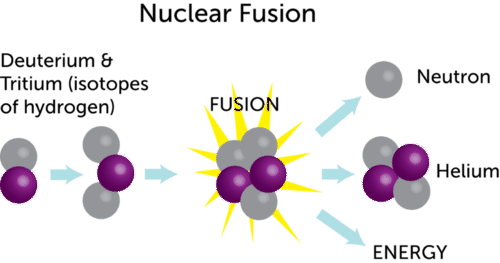As the demand for energy continues to increase, more and more greenhouse gases are released into the atmosphere. Clean energy is more important than ever to ensure our human survival on the planet. To this end, the European Union has set 2050 as the deadline for the complete decarbonization of global energy[1]. However, the road to achieve this goal is full of obstacles: solar energy requires a lot of space, wind and hydropower have relatively low output and can only generate energy in specific locations, and nuclear fission causes countless harms from nuclear waste to reactor accidents. When considering all the available options, the cleanest and safest way to power the world stood out: nuclear fusion.

Nuclear fusion involves placing a gas under immense heat and pressure, turning it into a plasma and fusing small atoms into larger ones, converting a small amount of mass into a large amount of energy. The energy produced by nuclear fusion is almost 4 million times that of burning coal, oil or natural gas, and about four times that of nuclear fission of the same quality. [2] Nuclear fusion does not release any greenhouse gases, but instead releases unstable nuclei that will remain radioactive for millions of years. It only produces inert helium. Fusion will not cause a nuclear accident, because unlike fission, it is not based on a chain reaction; if there is a problem with the reactor configuration, the plasma in the reactor will cool down and the reactor will automatically shut down within a few seconds. Fusion reactors cannot be used to make weapons because “although hydrogen bombs do use fusion reactions, they require additional fission bombs to detonate.” [3] Finally, fusion is achieved by the collision of deuterium and tritium, two isotopes of hydrogen. Deuterium can be produced from water and tritium from lithium, which is present in the ocean in trillions of metric tons, so “supply would not be a problem for millions of years.”[4]
Despite its incredible promise, nuclear fusion poses numerous technological issues, from confinement to plasma stability. [5] The “fundamental challenge” of fusion is to “make the fusion plasma emit heat faster than the energy velocity injected into the plasma”, and this is not yet accomplish. [6] The plasma must be kept at a high enough temperature so that the particles move so fast that they can get close enough to make the attractive force between the two nuclei effective and overwhelm the electrostatic repulsion. The solution to this problem is to create a self-sustaining “burning plasma”, which is “mainly heated by the energy generated by the fusion reaction occurring in the plasma, rather than heated by an external source.” [7] The fusion of deuterium and tritium produces a positive charge. Helium nuclei or alpha particles, and to achieve combustion plasma “At least 66% of the total heat [must] come from fusion alpha particles.” [8] This is the first step to unleash the myriad benefits of nuclear fusion, so I will study my research Focus on developing the first burning plasma ever.
The International Thermonuclear Experimental Reactor (ITER) is already making this effort. Existing research on combustion plasma has identified a number of technical challenges involved in its generation process. First, although the alpha particles released by fusion keep the plasma high, when present in large quantities, they can reduce the frequency of deuterium-tritium collisions, thereby cooling the plasma. Therefore, one of the main challenges in generating combustion plasma is to create an effective divertor to quickly remove helium from the reactor. [7] My research will focus on developing divertor materials that can withstand the heat of reaction and determining the correct removal rate to take advantage of the heating advantages of alpha particles without significantly reducing the frequency of deuterium-tritium collisions.
Another challenge is the development of a lithium-containing “blanket” surrounding the fusion core. In addition to alpha particles, fusion releases electrically-neutral neutrons, which produce heat and tritium when they collide with lithium. Both products can be used to sustain the reaction, maintaining high temperatures and replacing tritium consumed in fusion. The main challenges of blanket design include extracting tritium from the blanket, recycling it, and re-injecting it into the plasma.[7]
The third issue related to burning plasma involves density. That is, “increasing the plasma density is advantageous in principle because it increases the possibility of fusion reactions. However, as the density approaches its maximum value, many experiments have shown that the plasma confinement degrades more than expected.” One technique to solve this problem is machine learning: using statistical data and big data, artificial intelligence may be able to “identify important patterns and reveal information hidden in years of experimental data.”[8]
Mankind should treat issues such as climate change and nuclear war as issues to be resolved, rather than waiting for revelation. [9] And nuclear fusion power may be the solution we have been looking for. In the foreseeable future, nuclear power is not only the biggest solution; it is also the biggest challenge. But through the study of burning plasma, we can overcome this huge challenge and create a clean and self-sustaining response that will power the world for thousands of years.
Information from Stanford Advanced Materials.
References
- Jha, A. (2015, January 25). When you wish upon a star: Nuclear fusion and the
- Advantages of fusion. ITER. (n.d.).
- IAEA. (2016, October 12). Fusion – frequently asked questions. IAEA.
- Provide energy from fusion. Grand Challenges – Provide Energy from Fusion. (n.d.).
- Chatzis, I., & Barbarino, M. (2021, May 7). What is fusion, and Why is it so difficult to achieve? IAEA.
- Nuclear Fusion Power. Nuclear Fusion : WNA – World Nuclear Association. (2021, June).
- Baldwin, J. W. (n.d.). Fusion energy via magnetic confinement. Princeton University.
- Barbarino, M. (2021, May 6). Burning plasma. IAEA.
- Garfield, L. (2018, May 8). The author of Bill Gates’ favorite book suggests 9 big reasons the world is getting better. Business Insider.